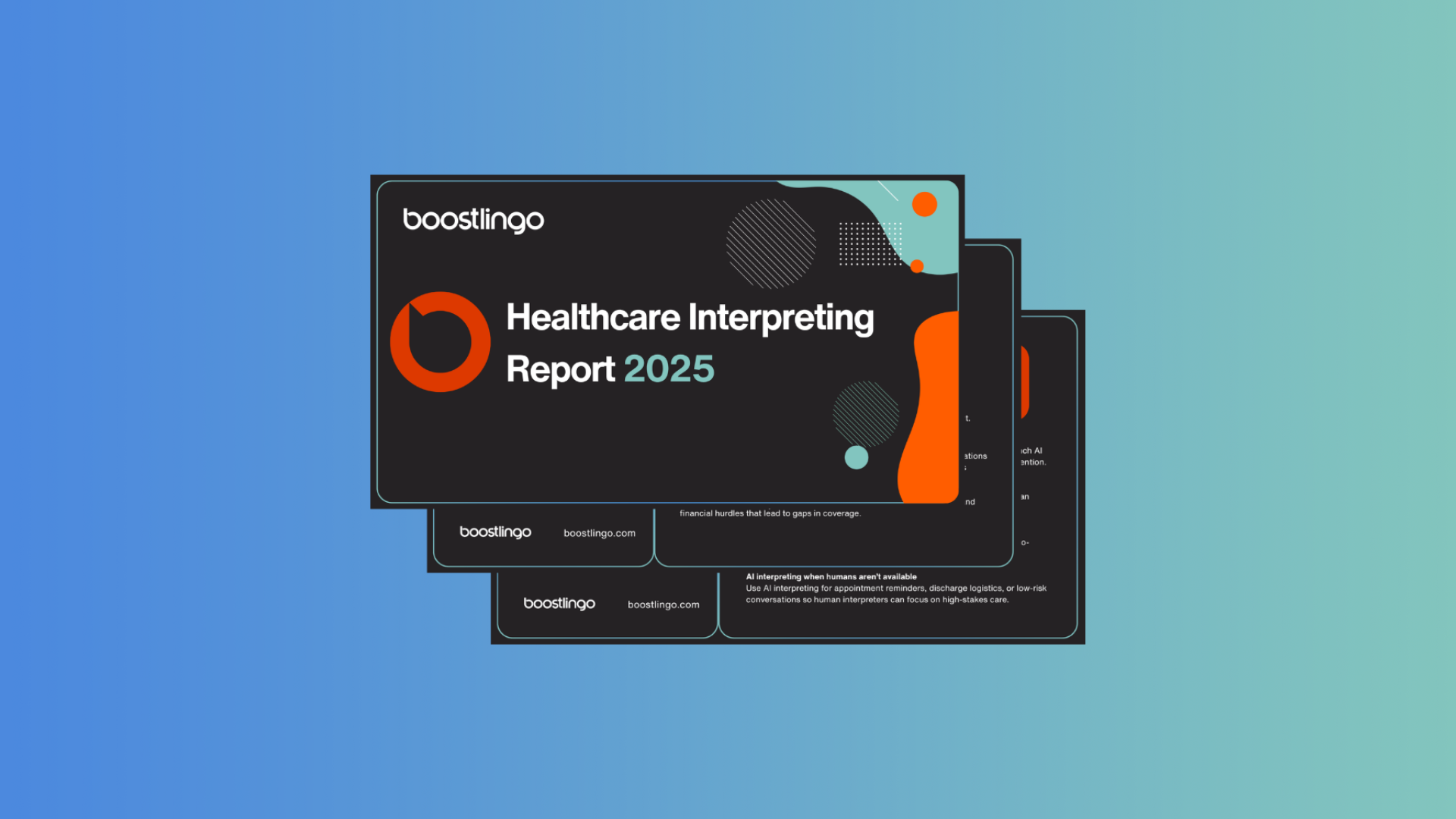Budget cuts are an all-too-familiar challenge for schools. But while trimming expenses may be unavoidable, scaling back language access services isn’t the answer. Doing so risks compliance issues, damages trust with families, and impacts student success. So how can schools protect these vital services—especially during periods of financial uncertainty?
Hi, I’m Carl Abesames, I write blog content here at Boostlingo. I’ve been covering the developments in language access across industries like healthcare, business, and government. A recent webinar featuring Giovanna Carriero-Contreras, Chair Elect from AAITE and Katharine Allen, Director of Language Industry Learning from Boostlingo, got me thinking more about what this all means for schools. That conversation highlighted the real budget pressures districts are under—and the innovative ways some stay committed to language access despite those challenges.
In this blog, we’ll focus on the education sector and how these changes impact schools, educators, and the communities they serve. We’ll also discuss practical, cost-effective strategies to keep language access strong, even when budgets are tight.
Language Access in Schools Matters More Than Ever
Across the country, K-12 schools are serving increasingly diverse communities. In the 2021–22 school year, approximately 10.6% of public school students in the United States were classified as English learners, totaling about 5.3 million students. For many families, English isn’t their primary language and interpreting and translation help them have equitable opportunities to engage with their schools, stay informed, and advocate for their children.
During the webinar, Katharine Allen, Boostlingo’s Director of Language Industry Learning, summed it up well “Schools are the only place where you have a 10 or 18-year relationship with a family. That makes communication—and by extension, language access—mission-critical.”
Why Language Access is Mission-Critical
- It supports meaningful communication between schools and families, which builds trust and drives student success.
- It gives non-English-speaking families the same opportunities to engage, participate, and advocate for their children.
- It enhances community connection, helps schools better reflect the diverse populations they serve, and gives immigrant children a better chance at becoming fully integrated, productive members of our society.
Beyond promoting family engagement, schools are also legally required to provide meaningful language access under Title VI of the Civil Rights Act and the Americans with Disabilities Act (ADA). And while federal policy disruptions are making headlines, Katharine reminded attendees of the webinar: “No laws have been overturned. The legal requirements to provide language access are still in place.”
Not Going Backwards with Budget Cuts
District leaders are navigating a complex landscape. Tight budgets, shifting federal policies, and administrative disruptions have left many wondering how to maintain essential services, including language services.
Giovanna shared,“There’s a lot of disruption and confusion right now. But cutting language access isn’t the answer—it creates risks and unintended consequences.”
Schools may be tempted to rely on untrained bilingual staff or volunteers for interpreting when budgets are strained. Giovanna warned against this, “We risk going back to what we’ve fought against: using unqualified resources to check a box. That’s not meaningful access, and it can have huge consequences.”
Risks of Relying on Bilingual Staff
- Bilingual staff may speak two languages, but that doesn’t mean they have the required language fluency or training as professional interpreters.
- Without formal training, there’s a higher chance of misunderstandings that can lead to negative outcomes.
- When untrained bilingual staff are pulled away from their primary duties to interpret, it stresses other employees who have to cover for them and can be more costly in the long run. Even with all the challenges, this moment gives school leaders a chance to reconsider their approach to language access. It’s about working smarter instead of harder, using thoughtful planning, tapping into the right technologies, and teaming up with trusted partners. When districts take this approach, they can maintain meaningful communication open l for every family while staying on budget and in compliance.
Practical, Cost-Effective Strategies to Sustain Language Services
Despite financial challenges, schools can implement smart strategies to maintain and improve their language services.
Centralize Language Services at the District Level
Rather than having each school manage services independently, districts can focus their efforts.
- Develop district-wide language access policies and procedures to ensure consistent quality and compliance across all schools, with a central coordinator to oversee language services.
- Eliminate redundant contracts and services by consolidating interpreting and translation resources at the district level.
- Pool funding and share technology platforms to reduce overhead costs and maximize shared resources.
Using AI for Routine Communication
Cost-friendly, AI-powered tools can handle routine, non-sensitive communication, like:
- Appointment reminders to help families stay on top of important meetings and avoid missed opportunities.
- Attendance notifications that encourage accountability and ensure parents are informed in real-time.
- General announcements that keep families engaged and connected to school events, building a stronger sense of community.
Abbey Adams, Boostlingo’s Account Manager for Education, noted “Some schools use AI live translation for one-on-one tutoring sessions or basic interactions. But for complex or sensitive meetings, they rely on live interpreters.”
Learn more about AI live translation with Boostlingo AI Pro.
Pursue Alternative Funding Sources
Many schools are tapping into private funding and grants to support language services. For example, some districts are reallocating private funds or securing grants for language access programs.
Engage With Your Community Stakeholders
Invite families, parent organizations, and community leaders into the conversation. Focus groups can provide valuable insights into the evolving needs of your multilingual communities. Listen to your communities; language access is not a one-size-fits-all solution. Collaboration can reveal solutions you hadn’t considered.
Pursue Alternative Funding Sources
Sensitive and complex interactions, such as special education meetings and disciplinary discussions, require the cultural nuance and emotional intelligence only trained interpreters can provide. In these situations, AI isn’t a substitute and is not legally compliant.
Katharine emphasized during the webinar: “AI can’t read a room. It doesn’t understand certain conversations’ cultural nuances or the emotional gravity expressed.”
Bridge the Gap with Boostlingo
We understand the pressures school leaders face today. That’s why we offer flexible, scalable solutions to help districts maintain language access services, even when budgets are tight.
Boostlingo’s Education-Focused Solutions
- Hybrid Models: Combine AI-powered tools with on-demand human interpreters to balance cost and quality.
- Boostlingo On-Demand: Access phone and video interpretation services when you need them most.
- Boostlingo IMS: Simplify scheduling, manage interpreters, and track usage across your district.
- Boostlingo AI Pro: Support routine communication with AI-powered live captioning, translation, and meeting summaries.
GOVMVMT
School districts can use Boostlingo’s contract with GOVMVMT to get better rates on language services and simpler procurement.
Learn more about our partnership with GOVMVMT.
Our goal is to help you streamline services and optimize costs without compromising quality or compliance.
How Schools Can Maintain Language Services in 2025
Ready to protect and sustain language access in your district? Here are five steps you can take:
- Conduct a Language Access Audit
Assess your current services, identify gaps, and evaluate needs for the next school year. - Engage Stakeholders
Include families, community leaders, and staff in planning conversations. - Leverage Technology Wisely
Make use of on-demand interpreting technology and pilot AI tools for routine communication, while reserving trained interpreters for high-stakes meeting - Stay Informed
Keep up with federal and state policies and tap into national resources like AAITE. - Partner with Experts
Work with trusted language service providers, like Boostlingo,to ensure scalable, compliant solutions.
Keep Communication Open
Budget cuts and uncertainty are making it more complicated than ever for schools to maintain the services their communities rely on. But language access isn’t a “nice to have”. It’s how families stay informed, feel welcomed, and stay connected to their child’s education. With thoughtful planning and the right tools, schools can continue to offer these vital services while staying within budget.
With the right strategy and partners, you can support families in your community and give them a voice. Want to learn how Boostlingo can help your district with language access? Reach us today for a free consultation.



